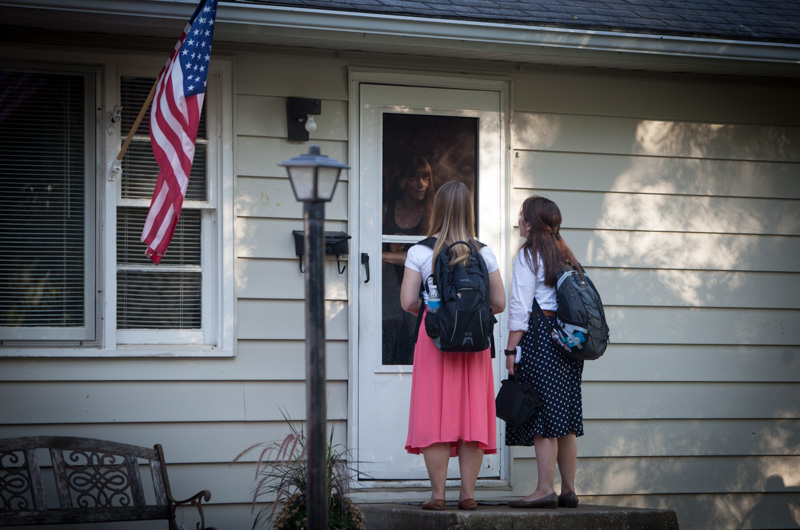(RNS) In Northern California, the image of Mormon missionaries in dark suits and white shirts, knocking on doors at inconvenient times, is being replaced by the sight of these name-tag-wearing twosomes in blue jeans and T-shirts, hoeing gardens, scrubbing off graffiti, dishing out food in homeless shelters and reading with refugees.

(Left) Sister Moody and Sister Ray speak with a Kansas City, Mo., resident about their mission on Sept. 10, 2013. The sisters are carrying out their mission at the Church of Jesus Christ of Latter-day Saints’ Independence Visitors’ Center in Independence, Mo. RNS photo by Sally Morrow
It’s part of the LDS Church’s recognition that its long-held practice of “tracting,” going door to door handing out church materials and delivering religious messages, is no longer effective. Now few people are home during the late morning and early afternoon, and those who are may not want to be disturbed.
“The world has changed,” LDS apostle L. Tom Perry said in June 2013. “The nature of missionary work must change if the Lord will accomplish his work.”
People today, he added, are often “less willing to let strangers into their homes.”
The LDS San Jose Mission already had discontinued tracting. Mission leaders got the word three years ago from church headquarters in Salt Lake City: Find something else for these eager, young full-time missionaries to do.
And it’s not about baptizing.
So San Jose leaders proposed that missionaries provide two hours of community service every day, five days a week — up from the normal four or so hours a week. This meant that Mormons would have to build partnerships with charitable organizations in their area that might need regular volunteers.
With the help of Web designers in Utah, LDS public-affairs officials in San Jose created a website called justserve.org, which lists organizations with service opportunities.
“We met with a lot of nonprofit organizations,” explained Randy Mack, an accountant and regional LDS public-affairs co-director. “We said, ‘Here’s what we are doing. If you have anything we could do, let us put these projects on our website.’ ”
The Mormon missionaries have taken to their new assignments with relish, he said. “They are welcomed and get very positive responses — a much different response than knocking on doors.”
Missionaries are less likely to have health problems or depression, and relationships between the pairs known as “companionships” have improved.
“It’s all been very positive,” he said. “The mission president is really excited about it.”
The San Jose initiative was a pilot program, but was followed about a year ago in Dallas and Denver. Others are urging that all Mormon missionaries perform extra community service.
Elder Chad Le Beau,18, of Peoria, Ariz., has been in the Bay Area for about seven months, as an American Sign Language missionary (both his parents are deaf). He and his companion spend a lot of his service hours helping out at the California School for the Deaf in Fremont.
“We volunteer at homecoming events, set up parking, cook hamburgers for everybody and help out at basketball games — keeping score, working the shot clock and interpreting for the refs,” Le Beau said. “I love service. It builds friendships and love that cannot be obtained through any other means.”
Other missionaries are helping with an after-school program in a low-income area in East San Jose, which serves kids who are at high risk for joining gangs, said September Higham, an LDS Relief Society president in Mountain View, Calif.
They “hang out with the kids, play handball, help with homework and provide other mentoring services.”
This organization reached out to the missionaries in particular, Higham said, “because they had trouble finding volunteers who were available between 3 and 5 in the afternoon.”
These young Mormons also help a neighborhood association clean up trash around the so-called “Jungle,” a large homeless encampment in San Jose and one of the biggest in the nation.
In addition, six to 12 missionaries clean out cow stalls and chicken coops, put in irrigation systems, and weed and mulch once a week at Hidden Villa, a nonprofit educational organization, Higham said. Another 15 missionaries work several times a week for a wildlife-habitat-restoration group called Acterra, removing invasive plants, planting native species and providing other services.
Each pair of missionaries has to find its own service opportunities, which fit within established guidelines:
- The service has to be within or near their assigned areas.
- Missionaries are not allowed to use power tools and can go only four steps up a ladder.
- Missionaries are not allowed to work directly with children in most cases. (Exceptions are where there are lots of adults around and the service is in a public area.)
- Missionaries always must be within sight and sound of their companions.
- Missionaries always have to wear their nametags.
When evaluating service prospects, missionaries are told “to use good judgment and protect the name of Christ.”
“We’re sending a whole generation of young missionaries back home with the awareness and the experience to engage in service in their own communities,” Higham said. “Some of these missionaries will become community leaders and the experience they gained at age 19 or 20 working with the homeless, at-risk youth, disabled individuals and other disadvantaged populations will become invaluable.”
(Peggy Fletcher Stack writes for the Salt Lake Tribune.)
YS END STACK





